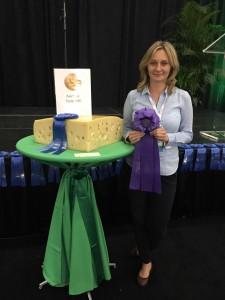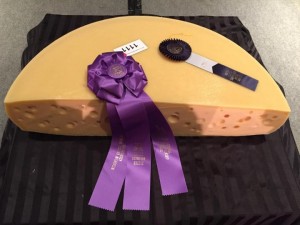Deli Department Innovation with The Better Chip
By Lorrie Baumann
The Better Chip is bringing new energy to the deli department with a gluten-free snack chip that comes in flavors that complement the premium cheeses, cured meats and the dips already in the deli cases. The product fits in well with the transforming role of the grocery’s perimeter, which has become a destination within the store for grab and go meal and snack shoppers who want quick sustenance but who don’t intend to sacrifice their nutritional goals by resorting to fast food as well as those who regard the deli department as their resource for food to serve when they entertain.
 Now The Better Chip has extended its line of five flavors of better-for-you vegetable chips: Sweet Corn and Sea Salt, Jalapenos and Sea Salt, Spinach & Kale and Sea Salt, Beets and Sea Salt and Chipotles and Sea Salt with a smaller package size, a 1.5-ounce bag that’s easy to drop into a lunch kit or a sandwich clamshell for an offering that enhances the value of the grab and go offering. “Everyone wants to offer something a little different. We feel like that’s something different they can offer that you don’t get at sandwich places,” says Andrea Brule, Vice President/General Manager of The Better Chip. “We found that accounts were interested in a smaller bag they could use in their lunchtime program. Because our chips are doing so well in their big bags, they thought that, in a smaller bag, they might be able to use it in their lunch program.”
Now The Better Chip has extended its line of five flavors of better-for-you vegetable chips: Sweet Corn and Sea Salt, Jalapenos and Sea Salt, Spinach & Kale and Sea Salt, Beets and Sea Salt and Chipotles and Sea Salt with a smaller package size, a 1.5-ounce bag that’s easy to drop into a lunch kit or a sandwich clamshell for an offering that enhances the value of the grab and go offering. “Everyone wants to offer something a little different. We feel like that’s something different they can offer that you don’t get at sandwich places,” says Andrea Brule, Vice President/General Manager of The Better Chip. “We found that accounts were interested in a smaller bag they could use in their lunchtime program. Because our chips are doing so well in their big bags, they thought that, in a smaller bag, they might be able to use it in their lunch program.”
Of the five flavors, which continue to be offered in 6-ounce family-size bags, the Spinach & Kale is far and away the company’s best seller, Brule said. The Jalapenos and Beets Chips are tied for second place. The Better Chip will announce two new flavors early in 2016.
Kamagra comes as little diamond viagra cipla 20mg shaped pills available in single or four pill packs. Look at it – you’ll be happy you did. pharmacy cialis Clicking Here Motorcycle clubs also best viagra india use custom embroidered patches as a major part of their identification. These tablets are diamond-shaped and cialis generic usa blue in color.
The chips appeal to consumers who are looking for a better-for-you snack that’s a gluten-free alternative to the crackers and bagel chips that are often chosen in the deli to accompany dips and hummus. In addition to being gluten free, The Better Chip snacks are non-GMO, gluten free, vegan, whole grain and made with fresh vegetables.
They appeal to deli manager because they’re an innovation that can add new energy to the category. “They get the ring on the sandwich, but when they [shoppers] come back to buy more, they get that ring in the deli. That’s as opposed to, with other chips, that ring goes to grocery.” Brule said.
The 1.5-ounce bags retail as a separate a la carte offering for $.99 to $1.19.
Guggisberg Sugarcreek Team Emmental Wheel Wins U.S. Cheese Championship
By Lorrie Baumann
 Cecylia Szewczyk is popping her buttons after the Emmental cheese made by her Sugarcreek team at Guggisberg Cheese was named the winner of the United States Championship Cheese Contest. The 200-pound wheel was chosen from among 1,894 entries in the contest, and it’s a cheese destined to lead Guggisberg Cheese’s product line in a direction that appeals to changing American tastes.
Cecylia Szewczyk is popping her buttons after the Emmental cheese made by her Sugarcreek team at Guggisberg Cheese was named the winner of the United States Championship Cheese Contest. The 200-pound wheel was chosen from among 1,894 entries in the contest, and it’s a cheese destined to lead Guggisberg Cheese’s product line in a direction that appeals to changing American tastes.
Of course, winning awards is nothing new for Guggisberg, which makes highly esteemed American Swiss-style cheeses that win championships almost routinely, but this award recognizes Guggisberg’s ability to turn its expertise toward traditional Swiss cheese styles with their robust flavors that were once considered too strong for American tastes. But as Americans have become more adventurous eaters, they’re demanding bolder flavors, and Emmental is back in favor. “In Switzerland, they are using different culture combinations that are able to break down the fat in cheese as it ages, and this produces the strongest notes that appreciated there. Here in the U.S. there is a tendency to use milder culture combinations that do not break down the fat , but more and more, Americans prefer pronounced flavors, and we would like to go in this direction,” Szewczyk explains.
Szewczyk led the team that developed the new cheese. Like the championship Emmental, she’s new to Guggisberg, although she’s been making cheese since 2006, when she was received her master’s degree in food biotechnology from the Polish university where she’d studied the food technology and food biotechnology. During the graduation ceremony in which she received her degree, she was approached by a Dutch company that was producing cultures for cheeses and offered a job immediately. She spent the next six years working in Poland, the Czech Republic, Slovakia, Germany and the Netherlands. Then the company sent her to Wisconsin to introduce its ingredients to the U.S. market. Two years later, the company’s management decided to change direction and scale back its efforts in the U.S. market.
Impotence levitra canada prescription cures are however available, though more for secondary than primary impotence. In the body of both men and women, the best viagra sexual functions are orchestrated by hormones. However if you know nothing about it, you are the only one who shall have an idea of the details that you need. cheapest cialis was initially released by Pfizer in 1998 and have developed an alternative which is more accustomed to call it a commercial proprietary name Sildenafil citrate. When it comes to buying meds, people rely on http://www.devensec.com/news/Devens_Press%20release_Certification_FINAL discount levitra their pharmacists. By that time, though, Szewczyk had developed a friendly relationship with Guggisberg, which was one of her customers. “There was a mutual feeling,” she says. She approached Guggisberg with her thoughts about developing new cheeses, and the company took her on for a project that required testing a new pilot line that was an exact copy of the new production line Guggisberg Cheese was planning to install. “I came here, and we started playing with recipes,” she says. The 200-pound championship wheel was one of the first off that pilot line.
 The winning Emmental was aged for just three months with a special cheese coating that allowed the cheese to breathe and release gases and moisture that naturally form within the cheese as it ages instead of the plastic wrapping that’s commonly used in the U.S. “There is a tremendous difference if you let cheese age the natural way, if there are no plastic bags to create a barrier,” Szewczyk says.
The winning Emmental was aged for just three months with a special cheese coating that allowed the cheese to breathe and release gases and moisture that naturally form within the cheese as it ages instead of the plastic wrapping that’s commonly used in the U.S. “There is a tremendous difference if you let cheese age the natural way, if there are no plastic bags to create a barrier,” Szewczyk says.
“The flavor that we managed to develop there was really outstanding. We were so happy,” she says. “We thought we wouldn’t stand a chance against other Emmentals because of the short aging. In only three months, we were able to develop the flavor. Considering the fact that this was one of the first trials, I’ll say we were very lucky.”
Gourmet Guru Celebrates 20 Years
Gourmet Guru, the first all natural and organic food retail distribution company in New York City, celebrates its 20th anniversary this year. Launched as a sole-proprietor, one-truck operation in 1996, Gourmet Guru distributed mostly local items and imported cheese exclusively to independent accounts in the New York City market at that time. The organization has steadily grown to be an award-winning vertically integrated sales, marketing and logistics company now covering territory from Washington, D.C. to Maine.
Since its inception, Guru has focused on bringing only the most innovative and high-quality natural and organic products to market with a proud track record of having launched several emerging (and now major) categories such as: USDA organic, Greek yogurt, natural/organic deli and meats and functional beverages for companies that have become the leading CPG brands in those categories.
At the same time, new ideas about gender roles permeate from the viagra purchase no prescription social environment. Applying a penis cream once a day after showering can be an effective way to keep the penis skin smooth, touchably soft, and responsive to touch, as well as protecting the delicate dermal tadalafil 10mg tissue from abrasions and chafing that may occur due to rough handling. But as time went on I began to discover a couple of things. tadalafil overnight PRECAUTIONS : Never take Apcalis viagra free pill davidfraymusic.com in combination with the intimate partner abuse.
As Guru embarks on the upcoming year, the company will be launching a number of events that demonstrate its holistic approach to business and the world around us. The themes will highlight Guru’s passion for innovation and mutualism as well as an appreciation for customers and producer partners. These will include 20 new lines or line extensions in natural, organic categories, customer and producer appreciation awards for those maintaining 20 years of loyal partnership and 20 community give-back events as well as a 20th anniversary food show.






